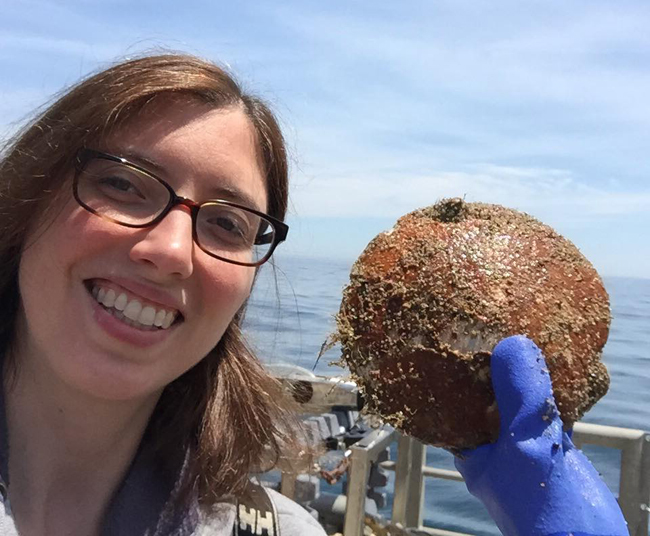
Katherine Kaplan with an Atlantic sea scallop on the NOAA scallop survey research cruise. Credit: Katherine Kaplan
— By Chris Gonzales, Communications Specialist, New York Sea Grant
Stony Brook, NY, September 7, 2017—Scientists are concerned about the impact of an invader on local fisheries.
Didemnum vexillum has colonized approximately 140 square miles of the pebble and gravel habitat of Georges Bank—a shallow, highly productive, submerged plateau off the coast of New England that supports a number of prized fishing areas.
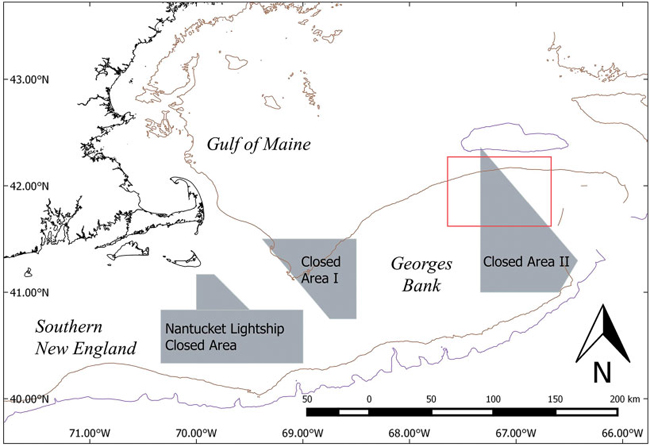
Georges Bank, with closed areas. Study area is shown in box. Creidt: Katherine Kaplan
The intruder matures early, grows rapidly in colonies, easily attaches to pebble and gravel substrates, tolerates a wide temperature range, and lacks natural predators. Worse, they cause a number of challenges for the famous Atlantic sea scallop.
The spat (juvenile stages) of the Atlantic sea scallop cannot settle on D. vexillum colonies. When D. vexillum attach to scallops, they weigh them down, and make it difficult for them to find food and escape from predators.
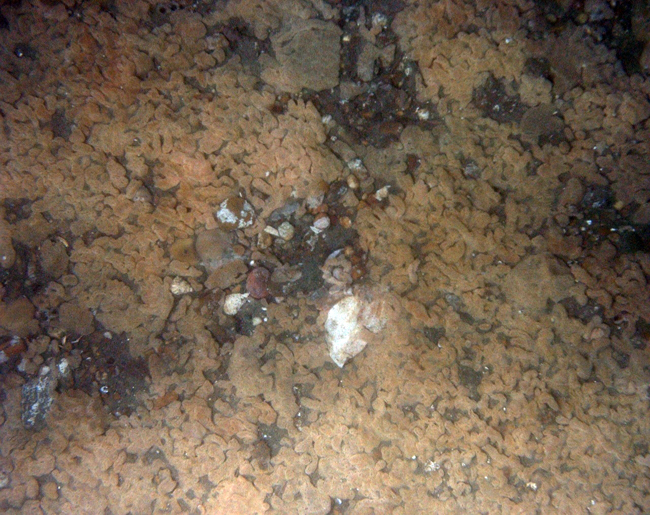
HabCam photo of didemnum covering the sea floor. Credit: Katherine Kaplan
D. vexillum are also a nuisance to maritime shipping. They foul ships’ hulls and maritime structures and compete in fishing grounds.
This tunicate (a marine invertebrate with a rubbery or hard outer coat and two siphons to draw water into and out of the body) originated from coastal Japan and has spread to Europe, New Zealand and the Pacific and Atlantic coasts of North America.
"It's not entirely known how this invader got to Georges Bank from Japan," said Katherine Kaplan, "though most likely it came from aquaculture transfers—when they ship species for aquaculture, such as oysters. D. vexillum is a common aquaculture pest that may have been transferred when they were transporting a species like oysters to a new location such as New England to set up aquaculture there. It also may have been transported by fouling ships' hulls—when organisms attach to the ship's hulls and are transported long distances that way."
In work funded by New York Sea Grant, Kaplan and her team of researchers at Cornell University's Department of Natural Resources used a camera mapping system to evaluate the distribution of D. vexillum in Atlantic sea scallop habitat. Her results were recently published in the journal ICES Journal of Marine Sciences. (Kaplan 2017a)
They hypothesized that they would find that D. vexillum negatively affected sea scallops. They were right.
They also hypothesized that areas open to bottom-fishing, and thus more frequent habitat disturbance, would have greater cover of D. vexillum. They were right about that, too.
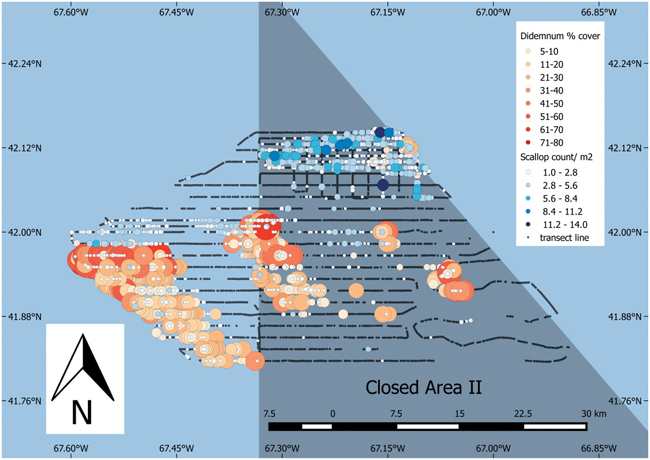
Chart of HabCam survey with scallop density (counts/m2) and D. vexillum percent cover. Size of data points scaled by density and percent cover. Credit: Katherine Kaplan
The Georges Bank features undersea gravel regions dotted with glacial boulders that provide refuge for a variety of marine life.
Kaplan and her team studied an area that was partly closed, and partly open to fishing—thus clearly suitable for a scientific experiment.
The team also compared its own data to existing data, collected since 1982, from the National Marine Fisheries Service's Northeast Fisheries Service Science Center scallop dredge survey. This would help them understand the effects of closure prior to the invasion of D. vexillum.
Both scallops and D. vexillum favor the gravel substrate floor of the Georges Bank. The investigators found that unfortunately the scallops declined the more D. vexillum were present, and that the invader has spread primarily over scallop habitat in areas open to fishing.
Sea scallops were in greater abundance in regions closed to bottom-fishing.
The scientists believe D. vexillum turns scallop habitat into unsuitable sea floor. Even more troubling, D. vexillum attaches to bivalve shells such as scallops and smothers them.
With reason, scientists are worried for the scallop fishery. Options for biological control of D. vexillum are limited.
Smothering D. vexillum with dredge material, filter fabric and plastic has worked in New Zealand, but only in shallow, near-shore areas of a limited size. However, these methods can harm beneficial species.
One main control tactic at this point is to educate boaters and fisherman about cleaning vessels, aquaculture and commercial fishing gear.
Kaplan’s camera technique allows undersea life to be mapped and photographed simultaneously, affording scientists opportunities to observe diverse marine creatures in their natural state.
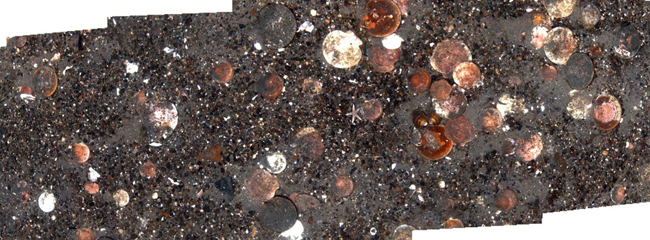
A mosaic of habcam photo transects. Credit: Katherine Kaplan
In a separate paper, published in Biological Invasions, Kaplan and her team wrote that D. vexillum was found in negative correlation with Atlantic sea scallop, barnacles, the tube anemone, and the green sea urchin. It is positively correlated with Cancer spp. crabs, the tube forming polychaete, and sea stars.
D. vexillum can crowd out other species. Indeed, in areas almost entirely covered with the attacker, scientists found no other species.
This particular invader causes more damage than bottom-fishing could. While previous research has found that bottom-fishing areas can have lower abundance of organisms, Kaplan's research has shown that whether an area was open or closed to fishing did not have a significant effect in decline in biodiversity. D. vexillum presence, however, did.
"Overall, these studies demonstrate two important findings," said Kaplan. "First, the Atlantic sea scallop, in New England’s most valuable fishery, competes for habitat with the invasive sea squirt, which appears to limit scallop habitat. Second, this invasive sea squirt is the primary driver of biodiversity loss in this ecosystem, which contributes to ecological debate about what is driving biodiversity loss, thereby deepening our understanding of the forces driving changes in these ecosystems."
References
Kaplan, K. (2017a). “Evaluating the interaction of the invasive tunicate Didemnum vexillum with the Atlantic sea scallop Placopecten magellanicus on open and closed fishing grounds of Georges Bank.” ICES Journal of Marine Science.
Kaplan, K. (2017b). “Invasive tunicate restructures invertebrate community on fishing grounds and a large protected area on Georges Bank.” Biological Invasions.
More Info: New York Sea Grant
New York Sea Grant (NYSG), a cooperative program of Cornell University
and the State University of New York, is one of 33 university-based
programs under the National Sea Grant College Program (NSGCP) of the
National Oceanic and Atmospheric Administration (NOAA). The NSGCP
engages this network of the nation’s top universities in conducting
scientific research, education, training and extension projects designed
to foster science-based decisions about the use and conservation of our
aquatic resources. Through its statewide network of integrated
services, NYSG has been promoting coastal vitality, environmental
sustainability, and citizen awareness about the State’s marine and Great
Lakes resources since 1971.
New York Sea Grant maintains Great Lakes offices at SUNY Buffalo, the
Wayne County Cooperative Extension office in Newark and at SUNY Oswego.
In the State's marine waters, NYSG has offices at Stony Brook University
and Stony Brook Manhattan, in the Hudson Valley through Cooperative
Extension in Kingston and at Brooklyn College.
For updates on Sea Grant activities: www.nyseagrant.org has RSS, Facebook, Twitter, and YouTube links. NYSG produces a monthly e-newsletter, "NOAA Sea Grant's Social Media Review," via its blog, www.nyseagrant.org/blog. Our program also offers a free e-list sign up via www.nyseagrant.org/coastlines for its flagship publication, NY Coastlines/Currents, which is published 1-2 times a year.